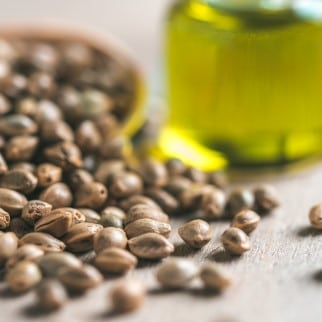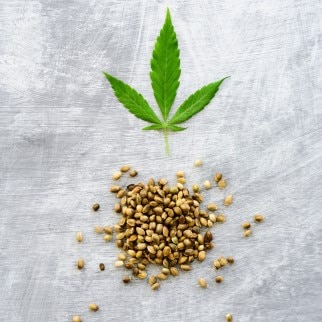Growing a Hemp Plant Requires Careful Planning and Execution
Posted on August 12th, 2021
A hemp plant is part of the Cannabis Sativa Species. Sadly, it’s association with marijuana has overshadowed its usefulness as an organic fiber source. But humans have spun hemp for centuries, because it’s fast-growing, like grass, and does not require much space for cultivation.
Hemp Plant Uses and Gender 
Hemp plants can be of either gender. You can tell by their pre-flowers, which show once they are over six weeks old. Male plants are better for sourcing fiber. But if you want to extract CBD from hemp flowers, grow unfertilized female plants.
After harvesting, you can use hemp seeds or extracts in foods and cosmetics, as fuel, or in lubricants and paint. After removing oils, you can even make seed cake for animal feed, beer, gluten free flour or hemp protein powders. And you can use its fiber for paper, textiles, rope, canvas, carpets, twine and other purposes.
Even better? Growing hemp suppresses weeds, and you don’t need to use herbicides or pesticides. Plus, if you rotate the plant with other crops, it helps to improve soil quality. (That’s because its deep roots encourage soil aeration.) Finally, hemp can grow from a seedling to a mature plant within two months, meaning you’ll get your crop quickly. Still, its better to wait at least four months before harvesting, depending on your growing conditions.
Best Growing Conditions
Hemp grows like weeds, so it withstands many growing conditions. But sunlight and soil condition can determine plant robustness. And, you’ll always start from seeds, whether you’re growing indoors, outdoors, or in a hydroponic system. If you choose indoor or hydroponic systems, you’ll need full spectrum lighting to mimic sunlight.
Because legal hemp plants must contain less than 0.3% THC, you need to seed from a registered dealer. Then, while the plant can grow in any soil, try to find well-drained land for best results. Still, you can improve weak soil by adding manure or nitrogen-rich compost. And you can improve drainage by adding small rocks or pebbles to the soil. Also start with dark brown seeds. Because, if they’re white or gray, they won’t germinate.
Grow a Hemp Plant: Getting Started
Germinating hemp seeds is a similar to any plant’s seed-start process. To begin, soak your seeds for 10 to 12 hours. That way, they’ll be primed for generation. Next, plant each seed one-inch deep into your soil mixture. Ideally, your soil’s pH value will be 6.5.
Remember, doming your seeds will maintain optimal humidity. and this is important, because you want air temperatures of 68 to 77 degrees F, and be 65 to 70 percent. It’s easy to control these factors indoors. It’s also easier to control your lighting, since the plants do best with about 12 hours a day to trigger flowering.
Now, what about watering? You want your seeds wet, but not waterlogged. To find that perfect balance, choose over watering. At this stage, you’ll apply a fertilizer mix of 3 Nitrogen, 1 Phosphorus, and 2 Potassium. Once germinated, transplant hemp seedlings to dry soil. You’ll know they’re ready when the seeds have roots at the bottom or on the sides.
Wondering how far apart to plant your seeds? If you’re growing for industrial purposes, keep them close together. That way, they’ll grow tall and produce more fiber. But if you’re growing them for flowers, space the plants so they grow short and wide. Basically, industrial hemp plants can grow just a foot apart. If you’re hoping to extract CBD, distance them at least four to six feet. And if you’re planting hemp for seeds, space them 7 inches to create more branches.
Early Days of Growth
During their early development hemp plants require a lot of water so that the roots can penetrate the soil and make the plants stable. The fertilizer used must have ratios of 1:3:4, unlike the 3:1:2 ratio needed during seed germination. While hemp grown in the open will have proper movement of air, indoor growing may need the provision of proper ventilation. Hemp requires 20 to 30 inches of rain if grown outdoors. Irrigation is necessary if natural conditions do not allow this. Water requirement during germination is high. Soil moisture must be maintained above 80 percent.
Harvesting can depend on the purpose of growing the hemp. It can be different for harvesting seeds, flowers, or fiber. For seed, you need to plant female plants. Seeds ripen six weeks after the plants flower, and then the ripened seeds fall to the ground. The seeds must be harvested as soon as they turn ripe and before the mother plant disperses them. Seeds can be stored for up to a year after harvesting.
When to Harvest Hemp Plant 
Harvesting hemp flowers requires them to have mature flower heads. Trichomes are tiny hairs that grow in the plant and these must be white and not translucent. At this stage the flowers will contain the highest concentration of cannabinoids. As the flowers are very delicate this process is often carried out manually by hand. After harvesting, the flowers they are sent for drying and curing, before they are processed further.
Hemp stalks have a very high yield of fiber that has many industrial uses. Hemp plants must grow tall if they are to have the right amount of fiber that can be harvested. Planting them in close proximity ensures this tall growth. Harvesting for fiber is easier than harvesting for flowers and seeds, and does not require any precise time or care. Hemp for fiber must be harvested by cutting the stalks 10 centimetres above the ground so that you do not cut through the woody portions, and have a greater amount of fibrous stems. Hemp for fibers does not need any testing for CBD content. The harvesting must be carried out when you have maximum volume of stalks of good quality. This can be anywhere between 90 to 100 days, and comes before any seeds have set.
We have gone through the entire process of growing hemp from the seed to the harvesting stages. Be clear about the final product you need before you start any planting, or decide on the area needed for growing a crop that will be of commercial benefit. Using hydroponics or growing hemp in a greenhouse or tent will require you to sped a lot of money on containers, tents, lighting, ventilation, and all these must be taken into consideration before you decide on your course of action. Normally hemp for fiber is grown in vast areas in the fields where extensive use can be made of agricultural machinery. For flowers and seeds you will not require these machineries. Source your seeds from reliable and registered suppliers, as this can be your best bet for a good hemp crop.




